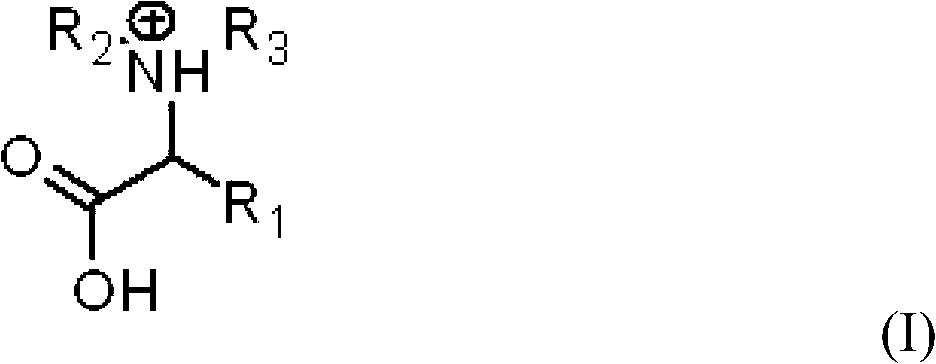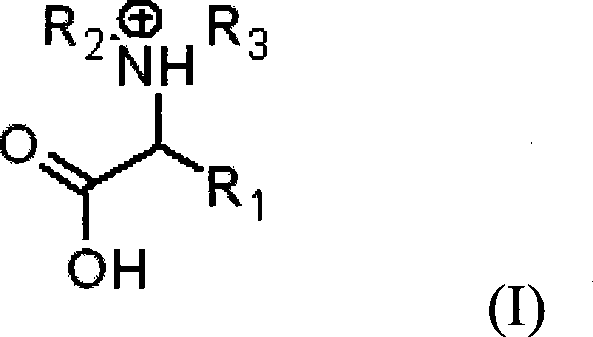Method for preparing amide
An amide and ionic liquid technology, applied in the field of amide preparation, can solve the problems of equipment corrosion, low-value ammonium sulfate, environmental pollution, etc., and achieve the effect of not corroding pipeline equipment
- Summary
- Abstract
- Description
- Claims
- Application Information
AI Technical Summary
Problems solved by technology
Method used
Image
Examples
Synthetic example 1-N
[0034] Synthesis example 1-N, the synthesis of the ionic liquid of N-dimethylaspartic acid sulfate
[0035] Take 25g of aspartic acid and place it in a 500ml round bottom bottle, add 60ml (concentration 37%) formaldehyde solution, then add 200ml water, and finally add 8g Pd / C. The air in the reaction bottle was replaced with hydrogen, and then the reaction bottle was placed in a hydrogen environment to react for 48 hours. After the reaction was completed, the residual hydrogen was replaced with nitrogen, and then heated to 90°C under reflux, and the Pd / C was filtered off at this high temperature to obtain a colorless aqueous solution. Concentrate the colorless aqueous solution, then azeotrope with 100ml toluene to further remove water, and finally dry the product in a high vacuum, then crush it with a spatula to obtain 28.92 g of N,N-Di Methylaspartic acid, yield: 95.54%.
[0036] Take 10g of dimethylaspartic acid and place it in a 250ml round bottom bottle, add 40ml of wate...
Synthetic example 2-N
[0037] The synthesis of the ionic liquid of synthetic example 2-N-methyl glutamic acid sulfate
[0038] Take 10g of glutamic acid and add it to a 250ml round bottom reaction bottle, then add 100ml of water and stir for 30 minutes, then take 20ml (concentration 37%) formaldehyde solution, add it to the reaction bottle, and place it at 80°C for reaction. After reacting for 3 hours, a yellow liquid was obtained. The liquid was concentrated, then azeotroped with 100 ml of toluene to further remove water, and finally the product was dried under vacuum to obtain 10.52 g of a yellow solid with a yield of 97.22%.
[0039] Add 100ml of water and 10.3g of the above-mentioned yellow solid (unsaturated intermediate) into the reaction flask), then add 5g of 10% Pd / C, replace the air in the reaction flask with hydrogen, carry out the reduction reaction under hydrogen, and carry out the reaction for 24 hours After the reaction is completed, replace the hydrogen with nitrogen, heat to 80°C, ...
Synthetic example 3-N
[0041] Synthesis of the ionic liquid of synthetic example 3-N-methylaspartic acid sulfate
[0042] Take 10g of aspartic acid and add it to a 250ml round-bottomed reaction flask, then add 100ml of water and stir for 30 minutes, then take 20ml (concentration 37%) formaldehyde solution, add it to the reaction flask, and place it at 80°C for reaction. After reacting for 3 hours, a yellow liquid was obtained. The yellow liquid was concentrated, then azeotroped with 100 ml of toluene to further remove water, and finally dried in vacuum to obtain 10.63 g of yellow solid with a yield of 97.52%.
[0043] 100ml of water and 10.5g of the above yellow solid were added to the reaction flask, and then 5g of 10% Pd / C was added to replace the air in the reaction flask with hydrogen, and the reaction flask was subjected to a reduction reaction under hydrogen for 24 hours. After the reaction was completed, the hydrogen was replaced with nitrogen, and then heated to 80° C., the Pd / C was filtere...
PUM
| Property | Measurement | Unit |
|---|---|---|
| melting point | aaaaa | aaaaa |
Abstract
Description
Claims
Application Information
 Login to View More
Login to View More - R&D
- Intellectual Property
- Life Sciences
- Materials
- Tech Scout
- Unparalleled Data Quality
- Higher Quality Content
- 60% Fewer Hallucinations
Browse by: Latest US Patents, China's latest patents, Technical Efficacy Thesaurus, Application Domain, Technology Topic, Popular Technical Reports.
© 2025 PatSnap. All rights reserved.Legal|Privacy policy|Modern Slavery Act Transparency Statement|Sitemap|About US| Contact US: help@patsnap.com



